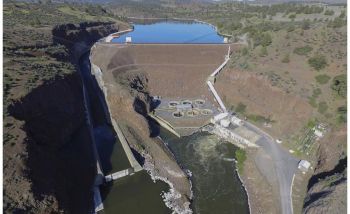Decommissioning: Difference between revisions
Rmanwaring (talk | contribs) (Created page with "__NOTOC__ ---- <!-- Delete any sections that are not necessary to your topic. Add pictures/sections as needed --> Dam owners and project stakeholders continually weigh the maintenance costs associated with safely operating a dam against its useful benefits. Negative effects of aging dams can include the risk of a dam failure, an accumulation of river sediment and loss of useful reservoir storage, the continued prevention of fish passage, the continued alteration of downs...") |
No edit summary |
||
| Line 1: | Line 1: | ||
__NOTOC__ | __NOTOC__ | ||
---- | ---- | ||
{{Picture | |||
|image= | |||
<!-- Add image file name (ex.image.jpg) --> | |||
irongate.jpg | |||
|link= | |||
<!--https://www.enr.com/articles/53978-largest-ever-us-dam-removal-project-gets-federal-agencies-nod--> | |||
|caption= | |||
<!-- Add picture caption --> | |||
The Iron Gate Dam is one of four dams along the Klamath River in Washington and California currently slated for closure/demolition. (Engineering News-Record) | |||
}} | |||
<!-- Delete any sections that are not necessary to your topic. Add pictures/sections as needed --> | <!-- Delete any sections that are not necessary to your topic. Add pictures/sections as needed --> | ||
Dam owners and project stakeholders continually weigh the maintenance costs associated with safely operating a dam against its useful benefits. Negative effects of aging dams can include the risk of a dam failure, an accumulation of river sediment and loss of useful reservoir storage, the continued prevention of fish passage, the continued alteration of downstream water temperatures, or a diminished ability to reduce both upstream and downstream flooding. “When the benefits provided by a dam have diminished over time, dam removal may be a less expensive alternative to continued maintenance and repair, or upgrades needed to address new dam safety or environmental concerns”.<ref name="USBR Dam Removal">[[USA Dam Removal Experience and Planning (ENV-2021-97)|ENV-2021-97 USA Dam Removal Experience and Planning, USBR, 2021]]</ref> | Dam owners and project stakeholders continually weigh the maintenance costs associated with safely operating a dam against its useful benefits. Negative effects of aging dams can include the risk of a dam failure, an accumulation of river sediment and loss of useful reservoir storage, the continued prevention of fish passage, the continued alteration of downstream water temperatures, or a diminished ability to reduce both upstream and downstream flooding. “When the benefits provided by a dam have diminished over time, dam removal may be a less expensive alternative to continued maintenance and repair, or upgrades needed to address new dam safety or environmental concerns”.<ref name="USBR Dam Removal">[[USA Dam Removal Experience and Planning (ENV-2021-97)|ENV-2021-97 USA Dam Removal Experience and Planning, USBR, 2021]]</ref> | ||
Revision as of 16:23, 12 September 2022

|
| The Iron Gate Dam is one of four dams along the Klamath River in Washington and California currently slated for closure/demolition. (Engineering News-Record) |
Dam owners and project stakeholders continually weigh the maintenance costs associated with safely operating a dam against its useful benefits. Negative effects of aging dams can include the risk of a dam failure, an accumulation of river sediment and loss of useful reservoir storage, the continued prevention of fish passage, the continued alteration of downstream water temperatures, or a diminished ability to reduce both upstream and downstream flooding. “When the benefits provided by a dam have diminished over time, dam removal may be a less expensive alternative to continued maintenance and repair, or upgrades needed to address new dam safety or environmental concerns”.[1]
“The level of effort needed to design a dam removal should be based on the size of the dam and the level of risk to the public, environment, and downstream property and infrastructure. The removal of a small weir may not require a detailed design. However, the removal of a large dam would require a detailed design to help ensure the safe and successful project implementation”.[1]
“Different strategies are required for removing dams based on their purpose, structural design, reservoir size, and the materials trapped within the reservoir. If the dam is still serving a useful purpose, then developing either water management strategies one or more replacement structures might be needed to continue to serve that purpose”.[1]
“Planning for dam removal generally includes these steps: define the purpose and need for the action; identify and engage stakeholders; assess the present downstream safety or environmental hazard risks; formulate alternatives, including removing the dam or repairing, improving, or maintaining the dam; assess environmental impacts under a range of reasonable alternatives; assess economic and financial costs and benefits under a range of reasonable alternatives”.[1]
“During and after dam removal, use flexible decision making that can be adjusted as outcomes from previous management actions and other events become better understood. Agree on the basic framework for monitoring, adaptive management, and decision-making for the overall project and incorporate that framework into the sedimentation management plan”.[1]
“The dynamic hydraulics and sediment processes involved in dam removal should be monitored and evaluated throughout dam removal and reservoir drawdown and for the duration of significant impacts. A systematic approach to performance monitoring and data collection can help quantify and evaluate impacts to determine how well the project meets objectives, how the reservoir and river are responding to the dam removal, and when adaptive measures may be needed. As noted in USSD 2015, ‘Monitoring can also help inform adaptive management plans by reducing uncertainty associated with dam decommissioning projects, communicate project results to stakeholders and the public, and advance our understanding of the results of restoration actions for future projects’”.[1]
Examples
![]()
Best Practices Resources
![]()
Trainings
![]()
Citations:
Revision ID: 2734
Revision Date: 09/12/2022
